Business
Plaze Review: Philly’s Fastest Growing DIY Networking App
Published
3 years agoon

I’ve been involved with do-it-yourself music in the Greater Philadelphia area for over a decade now. Throughout this time, I have occupied every potential role: showgoer, performer, promoter, you name it.
The groups I’ve ended up with typically share a similar genesis.
Here’s a picture: you’re sitting in a half-empty living room. Below you, a crowded basement pulses with tame tropes and half-hearted expressions. Some loudmouth nursing a 40oz foolishly exchanges charm for pretension and out from a groggy, smoke-induced stupor, an assertion springs: “Jawbreaker is the definitive Bay-Area rock band of the 90s. Miss me with that Green Day sh*t.”
Leaping (or staggering) to your feet, you fumble for rejoinders. It’s then that you find yourself thrust into a spirited dialogue with an equally impassioned stranger.
One thing leads to another. Chatting and chain-smoking, you trade visions, earnestly planning a potential project only to wake up the next morning without energy or interest in maintaining contact. After all, they smoked menthols— and your inner pre-teen still weeps to Green Day. You don’t need that kind of energy in your life.
The story repeats itself ad nauseam and there’s no light at either end of the tunnel.
Enter: Plaze. Philadelphia’s hottest DIY networking app. Aiming to revamp the way musicians discover one another, Plaze offers a digital alternative to the oft-excruciating process of starting a band.
What is Plaze?
Before I dig in, let me provide some background about Plaze. Like most innovations, Plaze was inspired by a problem. As stated in the first sentence of the Our Story portion on their website: “Plaze started with a problem.”
Call it journalistic intuition.
Co-founder Jamie Mallia, a drummer, recounts his story. It’s a common one, and we all have our own version. An exciting new musical partnership abruptly halted upon the realization that the person you have agreed to jam with is, shall we say, grossly incompetent.
Naturally, the unevenness of their skillset led to an awkward, short-lived alliance. That’s when the big idea hit: an app that facilitates discovery among creatives. One that promotes networking and collaboration while helping weed out the mismatches.
Plaze looks to one-up other avenues of creative networking like Facebook and Reddit. It does so by tailoring the experience to the expressed needs of its users. It is, however, currently a Philadelphia-centric app.
A New Way of Networking
For the sake of transparency, I must share my initial skepticism. And I’ll be the first to admit that this is likely the result of my reverence for the punk ethos. But honestly, that’s a stuffy holdover.
And punk, in its truest and most essential form, is about moving forward. Embracing change, even (and especially) when it threatens tradition. The fruits of punk that have prevailed throughout history have been those that, in threatening tradition, offers a constructive, democratic alternative. And so, with that renewed understanding in mind, I’m downloading Plaze.
Nowadays, there’s an app to help you with everything from grocery delivery services to keeping your mental health in check. So, really, why shouldn’t there be an app for meeting other local creatives?
Mind you, this article will encapsulate one person’s attempt at using the app.
My experience doesn’t speak for the whole of us. Everyone who uses this app, with their own style, expectations, intentions, and skill sets will undoubtedly yield a unique experience. With any hope, anyway.
In a sense, you can consider this less of a review and more of an account. The semantic difference is that, in this case, I won’t submit an official judgment.
How’s the User Interface?
Upon downloading Plaze, you’ll find that the interface is simple and intuitive. For those of us experienced with any of those countless dating apps, it’s downright familiar. This isn’t a dating app though, so there’s some hope for you yet. Just think of all the time you’ll save not having to worry about a punchy new pick-up line.
Features
All of the features are offered in a palatable four-tab menu. The tabs are as follows:
Profile
My Scene
Map
Explore
Profile

You’re going to want to add a picture or two. Really flesh out your profile here. Honestly, this function alone is pretty dope. Consider it a central hub for all of your artist profile pages. Now you can have your Bandcamp, Spotify, Facebook, Instagram, Youtube, and personal website all in one place. Artists are not terribly well-known for being, well, unlazy— so this certainly helps the discovery process along!
The profile section is also where you’ll outline your skillset. Shameless promotion here, but I need to show photos to properly explain.
This also provides me the opportunity to show off this sleek, seamlessly navigable interface. Despite being a millennial, my handling of most new technology is more in line with that of a 100-year-old man. But believe you me, sonny: this app is absolutely easy to handle. Golly!
You can write up a quick blurb about yourself and add all of your skills. This includes both on-stage and off-stage skills; which means audio engineers, promoters, teachers, and photographers all have a place in Plaze.
Whatever your niche, Plaze has thought of ways to plug it into the scene. Speaking of the scene, let’s hop to the next tab.
My Scene
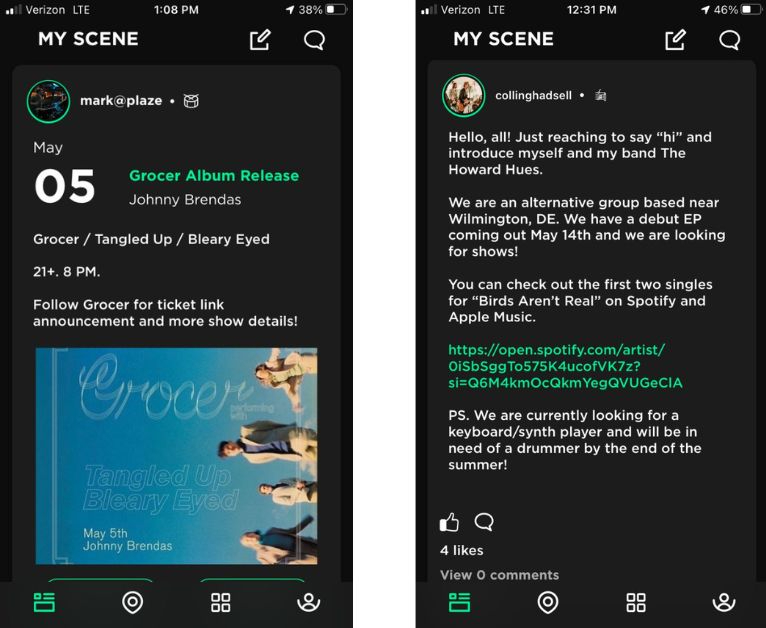
This function puts you in the same room as what’s happening in your area. At all times. The page is split up into two subsections, both of which are very simply laid out: Show Posters and Community. These sections borrow a lot of the convenient aspects of Facebook or Reddit.
Show Posters, as its name suggests, is purely a feed for flyers. It’s like an infinite scroll of calendar events for upcoming shows. You can interact with these the same way you would Facebook events, including RSVPs, comments, and likes.
Community is a collection of threads, not unlike Reddit, where people can post about any number of things. Want to promote an upcoming album release? Need a new drummer? Maybe you’re a promoter in search of an opening act. Whatever your need, this section allows you the freedom to express it.
Anyone can make a show flyer or community post!
Map
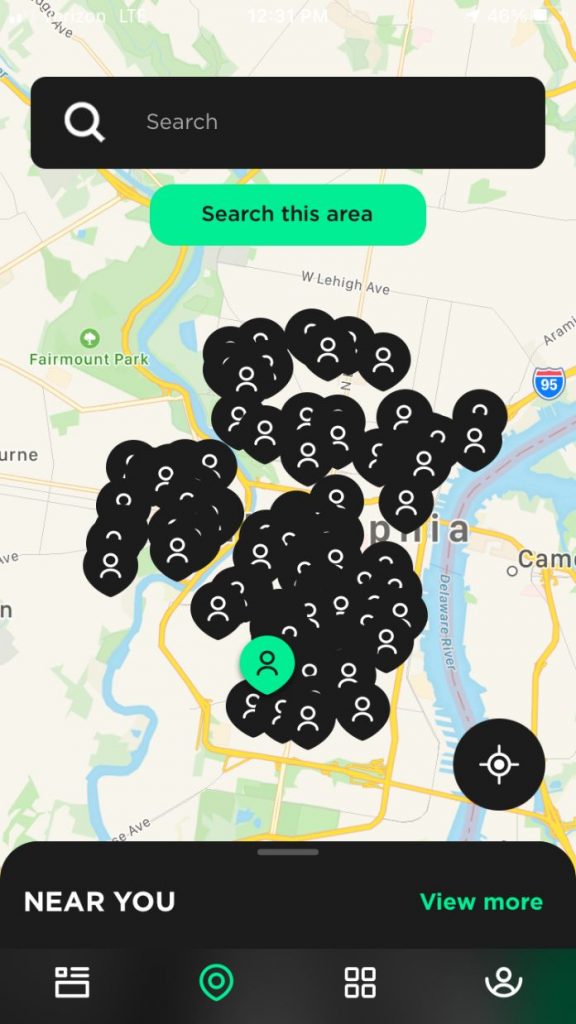
The map function essentially contextualizes people’s profiles in a geographic layout. This is a cool feature, but its benefits are limited to showing exactly where each individual profile is. It’s a helpful tool, nonetheless.
Explore
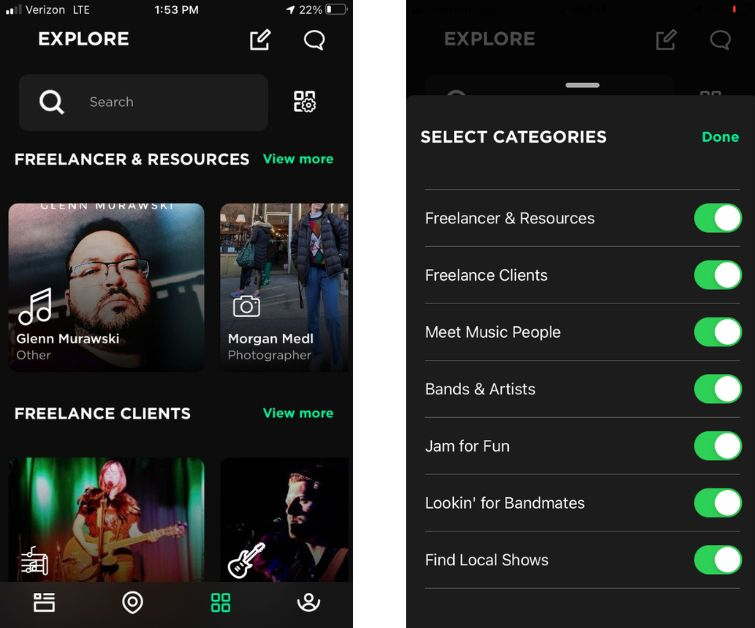
This page contains the meat and potatoes of the app. It provides full access to all other profiles on Plaze. A search bar at the top of the page offers a speedy look-up for specific people. Or you can scroll along casually, thumbing through profiles of Plaze users. (Plazers? Plazeers?)
To make it even more convenient, it splits up profiles into different categories based on each user’s expressed intent. Here are some of the subsections: Freelance Clients, Lookin’ For Bandmates, Jam For Fun, Find Local Shows, and Near You. It’s as simple as sending a message. From there, you’re free to discuss as you please! You can even curate your own feed, narrowing it down to your specific need.
Closing Thoughts: Is Plaze worth it?
Plaze offers an entirely free platform for exploring your scene. You stand to lose nothing, and the gains are immeasurable. it’s not limited to musicians, either. Plaze is perfect for artist-designers, audio engineers, promoters, podcasters, videographers, and journalists. Every creative personality is capable of offering (and monetizing) their skills with this app.
The most inspiring part of Plaze is the way it injects a burst of democracy into an experience historically fraught with crossed arms, naysayers, and gatekeepers. Gone are the days of not being able to find the right band members. And never again will you be burdened with the task of having to cold message a show promoter on Instagram, only to be left on read time and time again.
I can speak from experience regarding the difficulties of finding something as seemingly common as a good photographer. You end up just asking a friend with a camera and, oftentimes, you’re underwhelmed with the final product. With Plaze, freelancers are provided a large pool of potential clients and vice versa.
Just like every punk-rocker has a conversion story— a discovery of new, challenging, artistic integrity in the face of an otherwise bland, corporate landscape— so too may every DIY soul be converted into a Plaze-user (Plazite? Plazian? I hate this bit) and reimagine the possibilities of local art.
Even if they don’t f*ck with Green Day.
You may like
Business
Top 10 Best Places to Buy a Mid Century Modern Office Chair
Published
2 weeks agoon
July 4, 2025
What was once old is new again: mid century modern is back in style. From architecture to furniture, the postwar look is in, and the hype extends all the way to office chairs.
Do you need a mid century modern office chair in your life? If so, there’s plenty to choose from. Your office chair should be tailored to your style, whether you like luxury, utility, or something in between.
That’s why we’ve put together our 10 favorite places to find your ideal mid century modern office chair.
What is mid century modern design?
After World War II, spirits were high in the US, and new technology was taking the country by storm. Mid century modern refers to the design concepts that came about during this time.
As opposed to the frilly, ornate designs of classical furnishings, mid century modern designs are angular, material, and functional. Wood is a common design element, especially teak. Mid century modern furniture may also have materials like glass, vinyl, and metal. Designs are simple and geometric, with bold accent colors to make them pop.
The mid century modern aesthetic never really went away, but it’s made a noted comeback in recent years. Some have chalked it up to Boomer and Gen X nostalgia, others point to mid-century-set shows like Mad Men and The Marvelous Mrs. Maisel.
Why should I buy a mid century modern office chair?
Mid century modern is the perfect fusion of style and utility. If you want to cultivate an office space that commands respect without being ostentatious, mid century modern is the style for you.
When it comes to office chairs, an MCM one is often made with sturdy wood and vinyl. They combine the ergonomics of a modern office chair with old-fashioned grace.
If you’re concerned with utility and utility only, a more bog-standard office chair may suit you. But a mid century modern office chair is great for someone who wants to wow colleagues with a mature, thoughtful business space.
Where can I get a mid century modern office chair?
1) Wayfair
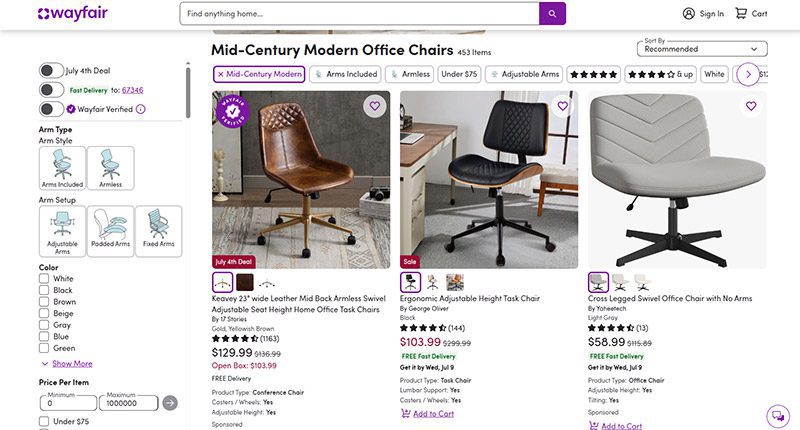
When it comes to furniture, Wayfair offers the best of both worlds. Their goods, including their mid century modern office chairs, are stylish and affordable. You can get a sturdy task chair for less than $100 or a more distinguished seat for less than $350.
MCM office chair examples: Dovray ($126), Bradford ($139), Lithonia ($133)
2) France & Son
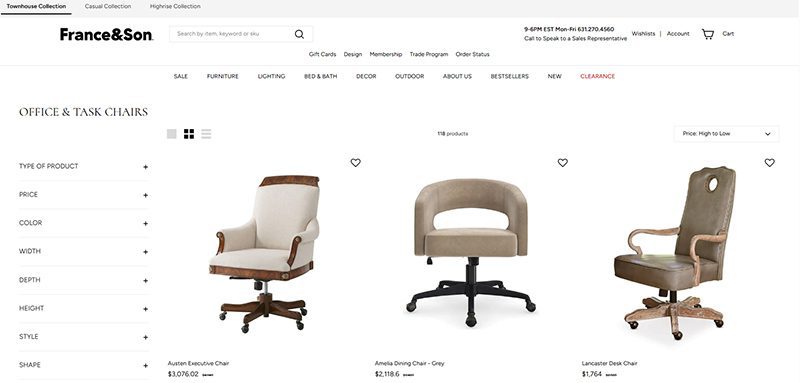
Wayfair’s chairs are affordable, but France & Son is the perfect option for luxury shoppers. Their mid century modern office chairs are robust and sleekly designed. If you dress to impress and enjoy the finer things in life, these are the chairs for you.
MCM office chair example: Brooks ($695)
3) Houzz
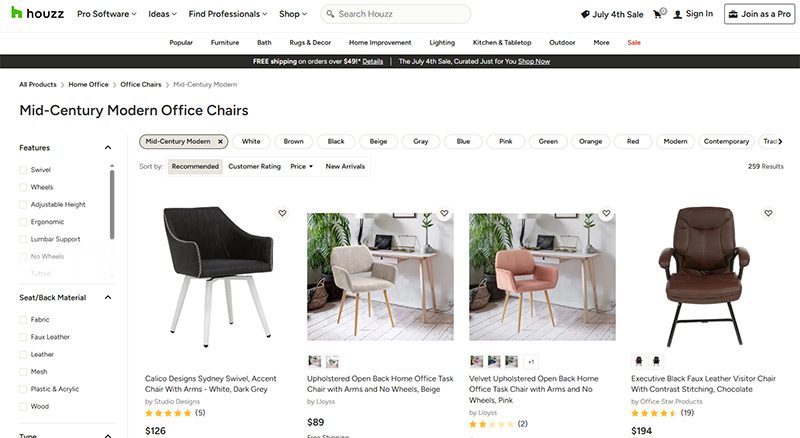
Started as a community for people to share home decor tips, Houzz has become a great ecommerce platform for finding stylish furniture. They’re more known for home decor than desk chairs, but they have plenty of great, affordable finds if you know where to look.
MCM office chair examples: Arvilla ($173), Rathburn ($259)
4) Laura Davidson
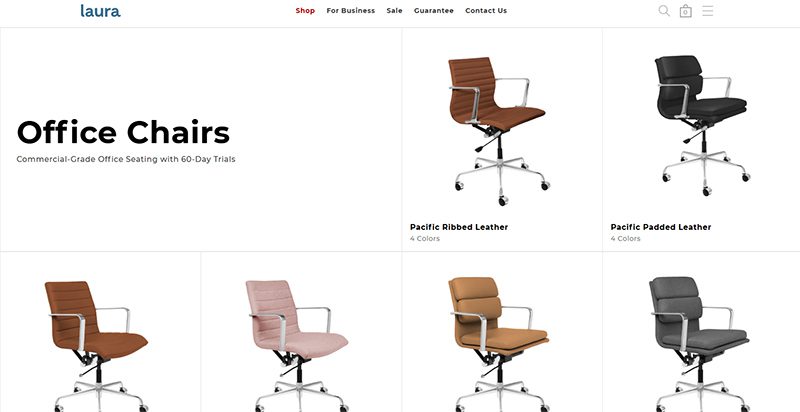
The Laura Davidson collection offers a fairly limited selection of classic office furniture. Still, there’s a reason they’re trusted by big-wigs like Apple, Disney, and Salesforce. Their chairs are sturdy and beautifully designed, reimagining classic Eames and Knoll designs.
MCM office chair examples: Rockefeller ($275), SOHO II Soft Pad ($450)
5) Icons of Manhattan
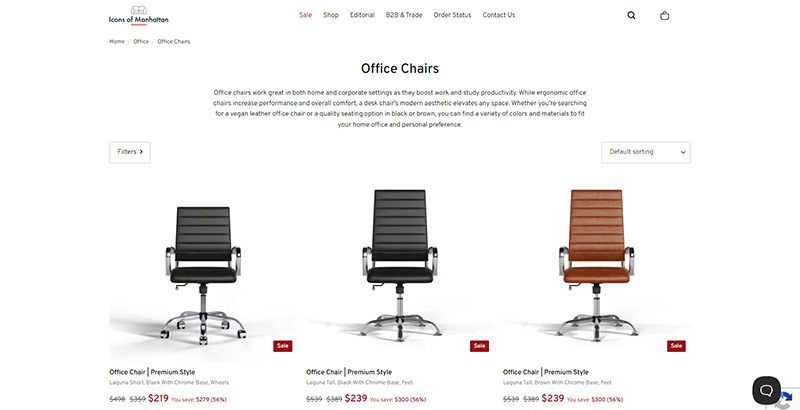
Icons of Manhattan has a simple philosophy: do one thing, and do it right. Their office chairs are handcrafted from premium materials and tailored to a mid-century modern style. If you want that Mad Men energy in your office (hopefully with a lot less angst), these are the chairs for you.
MCM office chair example: Ribbed Medium ($219)
6) Amazon
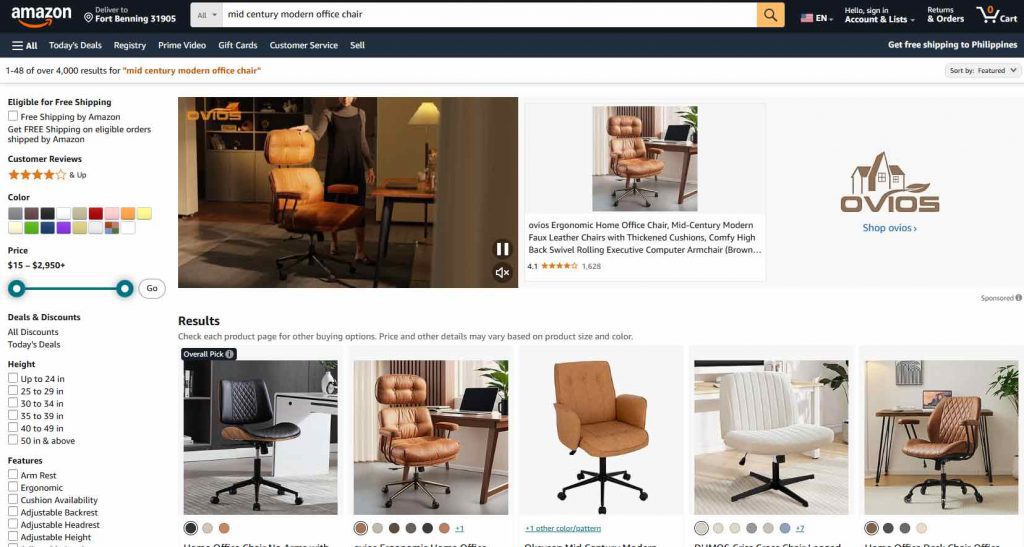
Yes, the internet’s premier shopping destination has a robust collection of mid century modern office chairs. Like with most products, their selection of seats is vast and can be hit or miss. Still, they’ve got stunning chairs available for any style, whether you care about comfort, class, or ergonomics.
MCM office chair examples: IDS Home Modern ($219), Art Leon MCM Swivel ($139)
7) AllModern
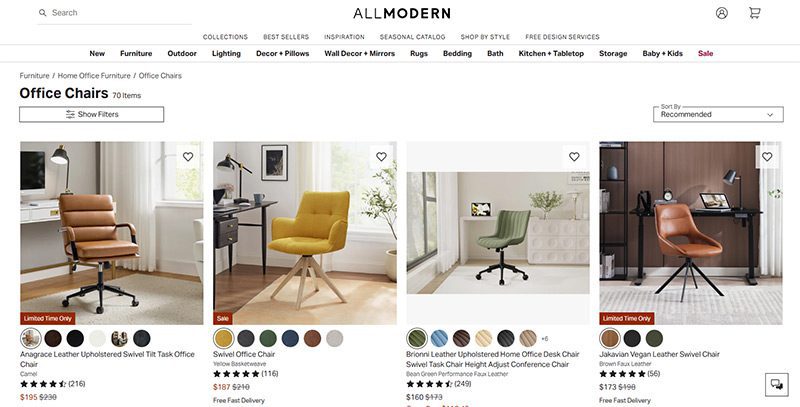
AllModern’s collection of desk chairs and other furniture truly embodies the mid century modern spirit. Their work is tight, angular, and functional above all. They’re part of the Wayfair family and they traffic in a number of modern styles, but their sleek chairs are perfect for any mid century modern space.
MCM office chair examples: Frederick ($229), Kealey ($349)
8) Overstock
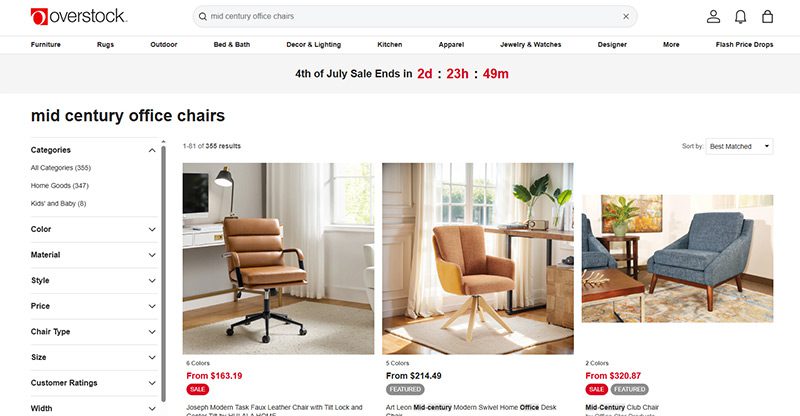
Overstock is known as a one-stop shop for quality home goods at sub-wholesale prices. If you want a spiffy mid century modern office chair that won’t break the bank, they’re the first place to look. While they’re somewhat less reliable than the more upscale platforms on this list, their selection is massive.
MCM office chair example: Joseph Modern ($163)
9) Walmart
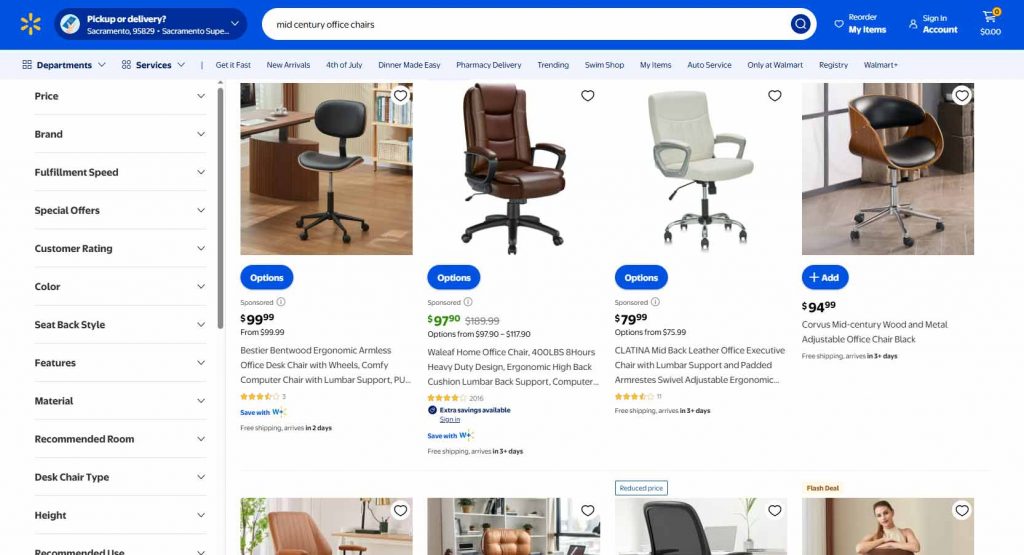
Hayneedle’s selection of mid-century modern office chairs falls somewhere between the minimal Laura Davidson and the endless Amazon catalog. Their array of mid-century designs is affordable and versatile, with chairs that match almost any style. While they may be part of the Walmart family, these chairs are anything but second-rate.
MCM office chair example: Waleaf ($97)
10) Target

Why splurge when you can save? As usual, Target is a hidden gem, offering a sturdy selection of mid century modern office chairs for some of the cheapest prices out there. Many of the chairs they offer are from the same designers as these other stores—Christopher Knight, LumiSource, Armen Living, etc.—at reduced prices.
MCM office chair example: Lombardi ($136)

A quality payroll service is one of the most invaluable tools any entrepreneur can have. Whether you’re a small business owner or an HR manager, paying your employees on time is crucial. This makes choosing a service even more weighty, after all, it is a heavy administrative burden. The good thing is, you can outsource this duty to an online payroll processor.
According to statistics, 49% of workers begin a new job search after just two paycheck errors, and with 65% of workers living paycheck to paycheck, it’s more important than ever to ensure an efficient, effective payroll process.
These services can save you precious time and mitigate potential issues. To make it easy for you to choose, we listed the best online payroll services for 2025.
Top 5 Online Payroll Services
Gusto
Gusto is a great option for both new and experienced payroll administrators, boasting an incredibly clean user interface and a first-rate payroll setup. Gusto lets you manage your employee’s time off (vacation and sick pay), company health insurance, and worker’s comp. Gusto offers excellent mobile access, too. This allows employees to manage aspects of their Gusto profiles, view payday insights, and access Gusto Wallet financial tools.
Gusto offers four tiers of membership, the most affordable of which is the Contractor’s Only plan, which offers unlimited U.S.-based and global contractor payments, supporting more than 100 countries, plus 1099 creation and filing at a rate of $6 per person per month with no base price.
The other three are Simple, Plus, and Premium. Here’s a deeper look into each plan:
Simple
Price:
$40/mo + $6/mo per person
Plan details:
- Full-service single-state payroll including W-2s and 1099s
- Employee profiles and self-service
- Basic hiring and onboarding tools
- Gusto-brokered health insurance administration
- Employee financial benefits
- Payroll and time-off reports
- Custom admin permissions
- Integrations for accounting, time tracking, expense management, and more
Plus
Price:
$80/mo + $12/mo per person
Plan details:
(All Simple plan features +)
- Full-service multi-state payroll including W-2s and 1099s
- Next-day direct deposit
- Advanced hiring and onboarding tools
- PTO management and policies
- Time tracking and project tracking
- Workforce costing and custom reports
- Team management tools
- Full support
Premium
Price:
Bespoke pricing, reach out for a personalized quote
Plan details:
(All Plus plan features +)
- HR Resource Center
- Compliance alerts
- Access to certified HR experts
- Full-service payroll migration and account setup
- Health insurance broker integration
- R&D tax credit discount
- Waived fees and exclusive pricing
- Performance reviews
- Employee surveys and insights
- Dedicated support
QuickBooks Online Payroll
Founded in 1983, Intuit is a California-based financial software company. Since its inception, Intuit has developed into one of the best-known providers of accounting software. Their online payroll service, QuickBooks, includes the essential features you need to run payroll.
QuickBooks offers three tiers of membership. The least expensive membership covers basic accounting features, such as invoices. For more features, check out the Essentials and Plus memberships. Each plan’s features are as follows:
QuickBooks Simple Start (2025)
- Price: $38/month for 1 user
- Best for: Freelancers and small teams with basic payroll needs
Features:
- Automated bookkeeping
- 5 free ACH bank transfers/mo for bills
QuickBooks Essentials (2025)
- Price: $75/month for 3 users
- Best for: Small businesses needing deeper financial tracking
Features:
- Includes all Simple Start features, plus:
- Recurring invoices
QuickBooks Plus (2025)
- Price: $115/month for 5 users
- Best for: Growing businesses with HR and compliance needs
Features:
- Includes all Essentials features, plus:
- AI-powered profit & loss insights
- Anomaly detection and resolution
- Budgeting
QuickBooks Advanced (2025)
- Price: $275/month for 25 users
- Best for: Established businesses with HR and compliance needs
Features:
- Includes all Plus features, plus:
- Custom user management and permissions
- Custom report builder
- Data sync with Excel
- Revenue recognition
- Forecasting
OnPay
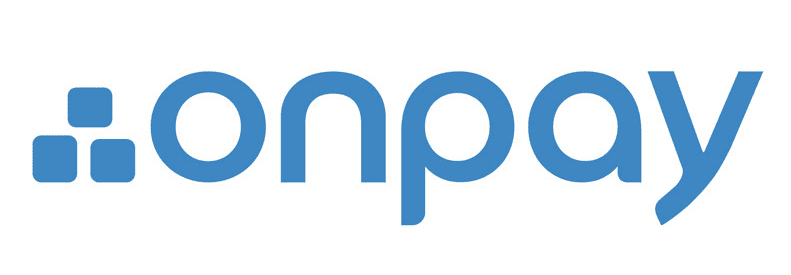
OnPay is a cloud-based full-service payroll processing system capable of running payroll according to a preset schedule, automatically disbursing wages, and calculating and withholding taxes.
OnPay can sync up with several other software your team is already using, making it easy to integrate the service into your team’s system. Another benefit of OnPays model is the simple, transparent pricing structure. No tiers; just one base rate.
Pricing:
$49/mo + $6/mo per employee
SurePayroll

SurePayroll’s award-winning service supports W-2 employees and 1099 contractors. Additionally, it handles 401(k) deductions and manages flexible spending accounts (FSA) and health savings accounts (HSA).
SurePayroll also offers a mobile app— available on both Apple and Android devices.
SurePayroll offers live support through its United States-based support team through chat, email, or phone.
Small Business Payroll
- Price: No Tax Filing: $20/month + $4 per employee, Full Service: $29/month + $7 per employee
- Best for: Small businesses and startups
Features:
- We file and deposit your federal and state taxes!
- Run payroll in 3 simple steps
- Schedule payroll to run automatically
- Unlimited payroll runs and free 2-day direct deposit
- Reports and pay stubs are available online 24/7
- Supports W-2 employees and 1099 contractors
Nanny & Household Payroll
- Price: Full-Service Household, $39/month, includes 1 employee, $10 per additional employee
Best for: Homeowners
Features:
- Signature-ready Schedule H
- We file & deposit your federal and state taxes!
- Run payroll in 3 simple steps
- Schedule payroll to run automatically
- Unlimited payroll runs and free 2-day direct deposit
- Reports & paystubs available online 24/7
- Supports W-2 employees & 1099 contractors
Be sure to choose a payroll service that works for your business, and provides you with the peace of mind that comes with a reliable bookkeeping system. Your employees will thank you.

Merck is currently in talks to acquire Seagen, a biotech company. The Wall Street Journal reports that the transaction is valued at $40 billion. And what happens if Merck acquires Seagen, and how would this acquisition benefit cancer research and treatment? Read more about the Merck Seagen buyout here.
Merck Seagen Buyout
Merck and Seagen are still deciding on their share prices. So far, talks have yet to reach an agreement on $200 per share. Both companies want to settle and finalize their deals before Merck announces its quarterly earnings on July 28. At the time of writing, Seagen’s stock was at $176.19.
With an estimated market value of $235 billion, Merck is looking to expand its presence in the cancer treatment space. The Merck Seagen Buyout could play a major role in that strategy. Since Seagen specializes in targeted cancer therapies, the acquisition would give Merck access to a broader range of oncology products.
Shareholder reactions to the new deal are overwhelmingly positive, and the stocks have been up since talks about the deal have been made public.
But this is not the first time that Merck and Seagen have made the news. Back in 2020, they collaborated because of cancer treatments. Seagen has a drug conjugate (ladiratuzumab vedotin) which would be used in conjunction with Merck’s Keytruda.
Merck reveals that Keytruda is its highest-selling product. It’s immunotherapy for cancer.
And this deal could help Merck offset the possibility of reduced sales because it will lose patent protection in 2028.
As promising as this deal is, there could be scrutiny from antitrust officials since there might be a litigation case from the Federal Trade Commission or Justice Department.
The Seagen buyout isn’t the only deal Merck has made recently. They’ve been busy closing another deal, but with Orion too.
Seagen
As a cancer biotech company, Seagen has therapies to ensure that patients benefit from the treatment and reduce any adverse side effects. Their treatments involve the therapy attacking tumors with toxins.
Merck partnering with Seagen isn’t a bad idea considering that Seagen made $1.4 billion in sales in 2021, most of it coming from Adcetris and Padcev (a treatment for urothelial cancers).
Merck-Orion Deal
In the middle of the Merck Seagen Buyout, Merck has recently partnered with Orion for the ODM-208 and other drugs. These drugs are related to the production of steroids. Orion found how it can combat hormone-dependent cancers and further developed this inhibitor.
Their deal includes that they should develop ODM-208 and promote it to the public together. And Orion will receive a $290 million payment from Merck.
Although they’re co-developing and marketing the new inhibitor, Orion will oversee the manufacturing side.
Co-developing the ODM-208 can help Merck with its current research and treatments for prostate cancer. President and CEO of Orion, Timo Lappalainen, says that this partnership will benefit Merck’s goals of treating cancer worldwide.
Other Ventures: Merck’s Role in the Pandemic
You may have heard about COVID-19 pills, which are a form of treatment for those diagnosed with mild to moderate COVID-19. Merck introduced an antiviral COVID-19 pill to the public. The name: Molnupiravir.
The COVID-19 pill is not a replacement for a vaccination. Instead, it stops the replication of the COVID-19 genetic code and keeps the patient out of the hospital. Not yet FDA-approved, Molnupiravir has been authorized for emergency use since December 23, 2021.
And for other stories, read more here at Owner’s Mag!

Should I Buy an Electric Scooter? What You Can Learn

Best Workflow Mapping Tools for Smarter Business Processes

Top White Label Marketing Tools for Agencies: Our 10 Best Picks

Virtual Reality Exhibit Carne Y Arena: The Refugees’ Plight

Top 10 Podcast Editing Software Applications for Beginners

What Is Tiktok Pink Sauce? The Viral Condiment, Explained

Did You Drop Your Smartphone in The Ocean? Here’s How to Retrieve It

Top White Label Marketing Tools for Agencies: Our 10 Best Picks

History of the NBA: The Success Behind the Big League

Demio SaaS 2025 Review: Features, Pricing, Pros & Cons

Did You Drop Your Smartphone in The Ocean? Here’s How to Retrieve It

Virtual Reality Exhibit Carne Y Arena: The Refugees’ Plight

Best Workflow Mapping Tools for Smarter Business Processes

Gift Guide: 25 Best Gifts for Women for All Occasions
Trending
- Technology17 hours ago
Top White Label Marketing Tools for Agencies: Our 10 Best Picks
- Technology22 hours ago
Virtual Reality Exhibit Carne Y Arena: The Refugees’ Plight
- Technology16 hours ago
Best Workflow Mapping Tools for Smarter Business Processes
- Technology23 hours ago
Top 10 Podcast Editing Software Applications for Beginners
- Lifestyle6 hours ago
Should I Buy an Electric Scooter? What You Can Learn





